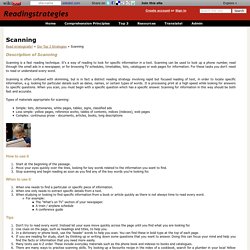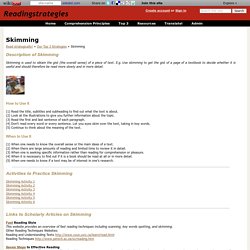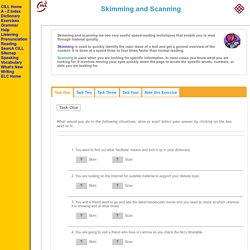

Semantic - Readingstrategies. Scanning - Readingstrategies. Description of Scanning Scanning is a fast reading technique.

It's a way of reading to look for specific information in a text. Scanning can be used to look up a phone number, read through the small ads in a newspaper, or for browsing TV schedules, timetables, lists, catalogues or web pages for information. For these tasks you don't need to read or understand every word. Scanning is often confused with skimming, but is in fact a distinct reading strategy involving rapid but focused reading of text, in order to locate specific information, e.g. looking for particular details such as dates, names, or certain types of words.
Types of materials appropriate for scanning: Simple: lists, dictionaries, white pages, tables, signs, classified adsLess simple: yellow pages, reference works, tables of contents, indices (indexes), web pagesComplex: continuous prose - documents, articles, books, long descriptions How to use it When to use it Tips Don't try to read every word. Activities for Scanning Next: Skimming - Readingstrategies.
Description of Skimming Skimming is used to obtain the gist (the overall sense) of a piece of text.

E.g. Use skimming to get the gist of a page of a textbook to decide whether it is useful and should therefore be read more slowly and in more detail. How to Use It (1) Read the title, subtitles and subheading to find out what the text is about. (2) Look at the illustrations to give you further information about the topic. (3) Read the first and last sentence of each paragraph. (4) Don't read every word or every sentence. When to Use It (1) When one needs to know the overall sense or the main ideas of a text. (2) When there are large amounts of reading and limited time to review it in detail. (3) When one is seeking specific information rather than reading for comprehension or pleasure. (4) When it is necessary to find out if it is a book should be read at all or in more detail. (5) When one needs to know if a text may be of interest in one’s research.
Activities to Practice Skimming Next: Skimming and Scanning. Quickly skim the article on Teamwork Skills to get a general idea of what each paragraph is about.

Then in the boxes write headings which express the key ideas of the paragraphs immediately below. Project work is a major focus of many undergraduate courses in Hong Kong and as such students often have to work on tasks together in groups. In order to work together effectively, students need to develop their teamwork skills. The ability to function together as a team is also an important life skill.
It helps people to get jobs, companies to succeed, charity organizations to help people in need, movies to be created, football teams to win, etc. So what precisely are teamwork skills? It is a fact of life that working with other people is not always easy and, therefore, you need to develop your teamwork skills to avoid potential conflicts. Pulp Friction: Timed Skimming Exercise. Every second, one hectare of the world's rainforest is destroyed.

That's equivalent to two football fields. An area the size of New York City is lost every day. In a year, that adds up to 31 million hectares -- more than the land area of Poland. This alarming rate of destruction has serious consequences for the environment; scientists estimate, for example, that 137 species of plant, insect or animal become extinct every day due to logging. In British Columbia, where, since 1990, thirteen rainforest valleys have been clearcut, 142 species of salmon have already become extinct, and the habitats of grizzly bears, wolves and many other creatures are threatened.
Much of Canada's forestry production goes towards making pulp and paper. Hemp has been cultivated by many cultures for thousands of years. However, there is a problem: hemp is illegal in many countries of the world. In recent years, two major movements for legalization have been gathering strength. Skillswise - Level 1 Factsheets and Worksheets. EAP Reading - Introduction.